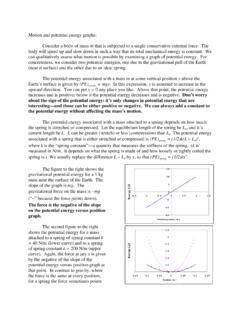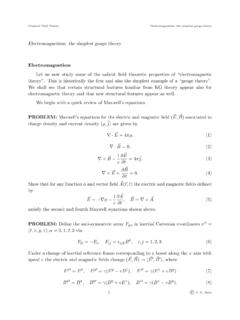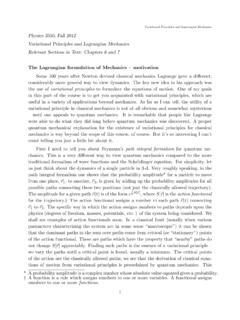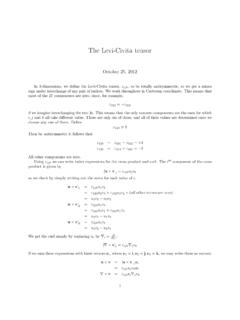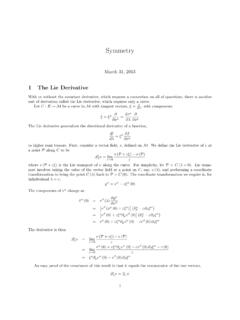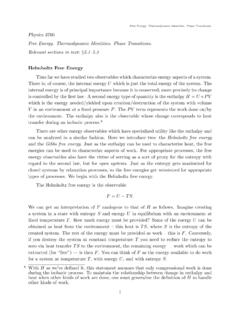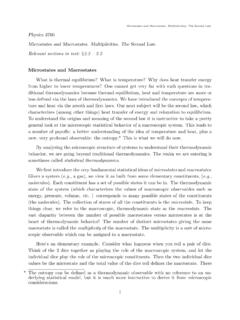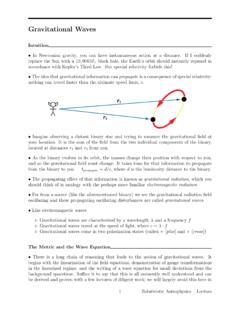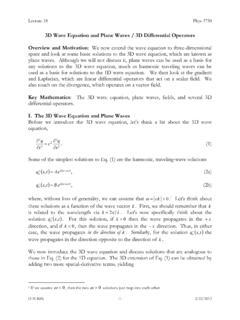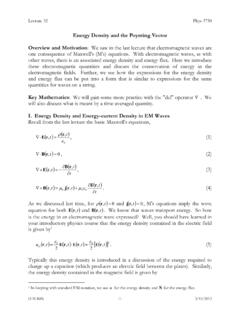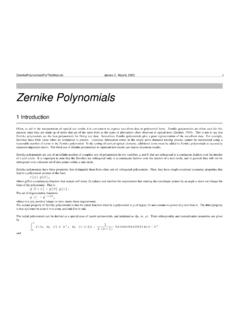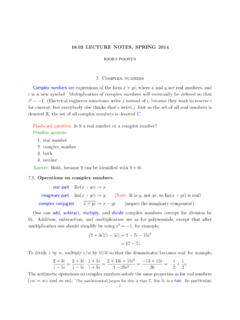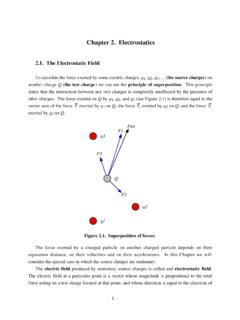Transcription of Vector derivatives - Utah State University
1 Vector derivativesSeptember 7, 2015In generalizing the idea of a derivative to vectors, we find several new types of object. Here we look atordinary derivatives , but also the gradient, divergence and CurvesThe derivative of a function of a single variable is familiar from calculus,df(x)dx. The simplest generalizationof this is when we have a curve in two or three dimensions. Acurveis a smoothly parameterized sequenceof points in space. You are familiar with this idea from mechanics, where a particle s position may beparameterized by time,x(t) = (x(t),y(t),z(t))At any timet, these three functions give us the position of the moving particle.
2 The complete path of theparticle is a curve .We can produce a second Vector , the velocity Vector , from this position Vector by differentiationv(t) =dx(t)dt=(dx(t)dt,dy(t)dt,dz(t)dt)We differentiate each of the three functions with respect to the parameter. This result generalizes to ar-bitrary curves and parameterizations. If we have a curve parameterized by any parameter ,x( ) =(x( ),y( ),z( )), then differentiation gives a tangent Vector to the curve at each point,t( ) =dx( )d Many parameters can give the same curve.
3 For example,x(t) = (x(t),y(t),z(t))=(v0xt,y0yt,12gt2)andx( ) =(v0x 2,y0y 2,12g 4)describe the same path in space. However, the length of the tangent Vector will depend on which parameteris chosen. Thus,v(t) =dxdt= (v0x,v0y,gt)1gives the velocity, but (using 2=t)t( ) =dxd = 2 (v0x,y0y,g 2)= 2 v(t)is merelyproportionalto the The gradientWe can produce a Vector from a scalar ( , a function) by differentiation. Suppose we have ascalar field,that is an assignment of a number to each point of Euclidean3-space: = (x,y,z) = (x)This is just the opposite of a curve.
4 Now we have one function of three variables instead of three functionsof one order to distinguish the different possible derivatives of , we use apartial derivative, holding two ofthe independent variables constant while we differentiate with respect to the third, x= lim 0 (x+ ,y,z) (x,y,z) where the expression on the right is the usual definition of the derivative of a function means that we have three distinct deravitives of a function, characterizing how it is changing in eachof the three coordinate directions.
5 We make a Vector of these by combining them with the basis vectors inthe corresponding directions. The resulting Vector , thegradient, gives us the direction in which is changingthe fastest: i x+ j y+ k z(1)Notice that thedel operator, , is written in boldface or with an arrow, because it results in a that we write i x+ j y+ k zinstead of x i+ y j+ z kto avoid any confusion about whether thederivative also acts on the basis vectors. This doesn t matter in Cartesian coordinates since the Cartesianbasis vectors are constant, but it does matter in other bases.
6 For example, rdoes not vanish because thedirection of rchanges as we vary .We may write del as an operator without necessarily applying it to a function, i x+ j y+ k z(2)and, as such, it is avector-valued operator, or simply a Vector we have a unit Vector , n, in an arbitrary direction. Using the angular expression for the dotproduct, the directional derivative of in the ndirection is then n =| n|| |cos =| |cos where| n|= 1and where is the angle between nand . This expression is clearly largest whencos = 1and therefore = 0.
7 This means that the direction of the Vector , , maximizes the directional derivativesof , thereby giving the direction in which is changing the (Problem ): Find the gradient of the radial know thatr= x2+y2+z2is the magnitude of a radial Vector ,r=x i+y j+z kso the gradient is r=( i x+ j y+ k z) x2+y2+z2= i x2+y2+z2 x+ j x2+y2+z2 y+ k x2+y2+z2 z=121 x2+y2+z2( i (x2+y2+z2) x+ j (x2+y2+z2) y+ k (x2+y2+z2) z)=121 x2+y2+z2(2x i+ 2y j+ 2z k)=1rr= rExample: Gravitational potentialFor example, the gravitational potential energy around a sphericalplanet falls off as1r, = GMmrThe negative of the gradient of the potential energy gives the gravitational force,F= =GMm (1r)We use the chain rule with each derivative, x(1r)= 1r2 r xso the full gradient isF= GMmr2 r= GMmr2 r3 DivergenceWe have seen that we may act with the del operator on a scalar field to produce a Vector .
8 We may also applythe del operator to avector fieldto produce a scalar. A Vector field is an assignment of a Vector to eachpoint in our space,v(x,y,z). Define thedivergenceofv(x,y,z)to be the dot product of the del operatorwith the Vector field, v(x,y,z) ( i x+ j y+ k z) (vx i+vy j+vz k)Using the distributive property of the dot product and the product rule of differentiation, we expand thefirst term i x (vx i+vy j+vz k)= i x (vx i)+ i x (vy j)+ i x (vz k)3= i x(vx i)+ i x(vy j)+ i x(vz k)=( i vx x i+vx i i x)+( i vy x j+vy i j x)+( vz x i k+vz i k x)
9 Now, using first the constancy of the Cartesian unit vectors and then the orthogonality of the basis, thisreduces to i x (vx i+vy j+vz k)= vx x i i+ vy x i j+ vz x i k= vx xSimilarly the second and third terms of the original expression give us vy yand vz z, respectively. The finalresult is the sum of the three terms, v(x,y,z) = vx x+ vy y+ vz z(3)The divergence tells us how much a Vector field is increasing as we move outward. The divergence theorem,which we discuss later, quantifies this statement perfectly.
10 In the meantime, consider some examples to geta sense of what is of a constant Vector fieldLet a Vector field be specified to be the same Vector at eachpoint,v(x,y,z) =v0= (vx0,vy0,vz0). Then all of the deriatives vanish, and we have v= field in thex-direction, increasing in they-directionThis also gives zero. We might takethe Vector field to bev(x,y,z) =y3 iThe divergence is then v(x,y,z) = vx x+ vy y+ vz z= x(y3)= 0 Clearly, we need somex-dependence of thex-component,y-dependence of they, and so on.
